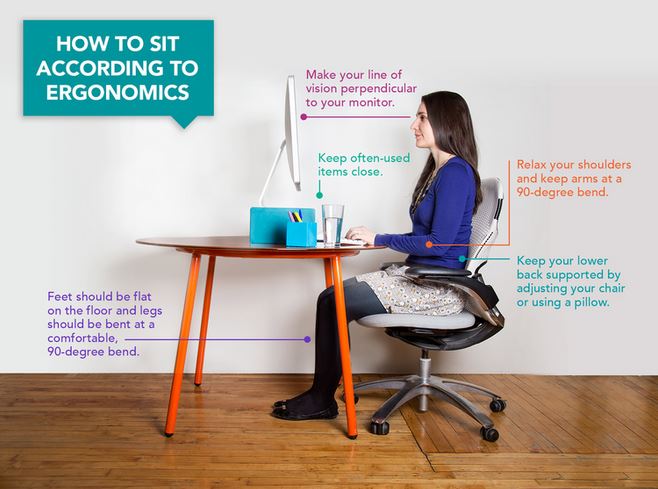Don’t let this infographic fool you—we know sitting can be bad for our health. It’s been linked to an increased risk for cardiovascular disease, diabetes, and even cancer . Not to mention, sitting for long periods of time can cause your muscles to become inactive, and has you burning one calorie a minute, a third of what it would be if you were walking . And that’s even when you have good posture!
But most of us don’t even have good posture. We’re sitting like contortionists and twisted pretzels, setting ourselves up for a lifetime of pain and injuries . And although standing desks (or even treadmilll desks) are trendy, they haven’t become the office norm just yet—making sitting the majority of the day pretty inevitable.
To avoid the scary consequences of days spent on our rears, we teamed up with Alyx Brown, a chiropractor at Manhattan’s Urban Wellness Clinic, to find the best way to sit at our desks.
1. Computer Monitor and Eyes
It’s important to have your eyes in line with the area of the screen you focus on the most, whether that’s the top (if you’re sending lots of emails), or the bottom (if you’re writing a bunch of code). Looking down at your screen puts excess strain on your neck, which leaves you vulnerable to injuries such as cervical disc herniation, cervical strains, and headaches. Stacking books under your monitor is a simple trick if you need to raise your screen to be at eye level. And if you happen to be a multi-monitor worker, make sure you apply this tip to the monitor you use the most—the last thing you want is an injury from looking sideways all day.
2. Desk
Anything that you constantly use (think your phone, mouse, or water bottle) can be a stressor on your body if you’re always reaching out to grab it. Instead of forcing your body to overwork (and be in an uncomfortable position), keep these must-use items within a foot.
3. Arms
When your arms are stretched and extended, your shoulders actually start to rotate forward, causing you to lose strength in your upper back. To avoid shoulder injuries and chronic upper back pain, keep your arms at a comfortable 90-degree angle in a nice, neutral resting position. Chairs come with armrests for a reason, so don’t be afraid to let them lend you a helping hand!
4. Back
You want your back to be comfortable and supported, with a small curve in the lumbar spine where your natural lower back (or lordotic curve) is. Without support, the back tends to get too much of a curve in the opposite direction—what’s known as kyphosis, or more commonly, hunchback—leaving the lower back perfectly exposed to disc herniation and chronic postural lower back sprains and strains (the most common injuries Brown sees). If you don’t have a chair that can provide support, get creative! Pillows and jackets are the perfect solution to such a problem.
5. Legs and Feet
When your legs are crossed or just your toes are touching the floor, you’re putting unnecessary stress on large supportive muscles and hampering proper blood flow (hello, pins and needles). Even little things—like keeping your legs crossed all day long—can lead to chronic pain. It’s of course OK to cross your legs every once in a while, but it’s important to be aware of your body position.
6. Vertical Alignment
While seated, you never want to be reaching or leaning forward. Why? Well here’s a fun fact: For every inch that the head comes forward, the spine feels like is has taken on an extra 10 pounds—bringing on some major strain for your muscles.
The Takeaway
Little changes to your posture matter. Bad sitting habits—from slouching to crossing your legs—can lead to serious injuries and chronic pain. Fortunately, most of these issues are preventable, and regardless of if you’re big or small, there’s a creative way to make your desk setup and posture a bit better. (There’s zero shame is stacks of printer paper people!)
It won’t feel awesome at first—we know the ideal posture is rarely the most comfortable—but that doesn’t mean you should give in to your long-standing (er, sitting) habits. Try slowly incorporating these changes (i.e. five minutes every half hour at first) to get your body adjusted to a healthier posture, and over time, sitting properly won’t feel awkward at all. You better believe your body will thank you.


